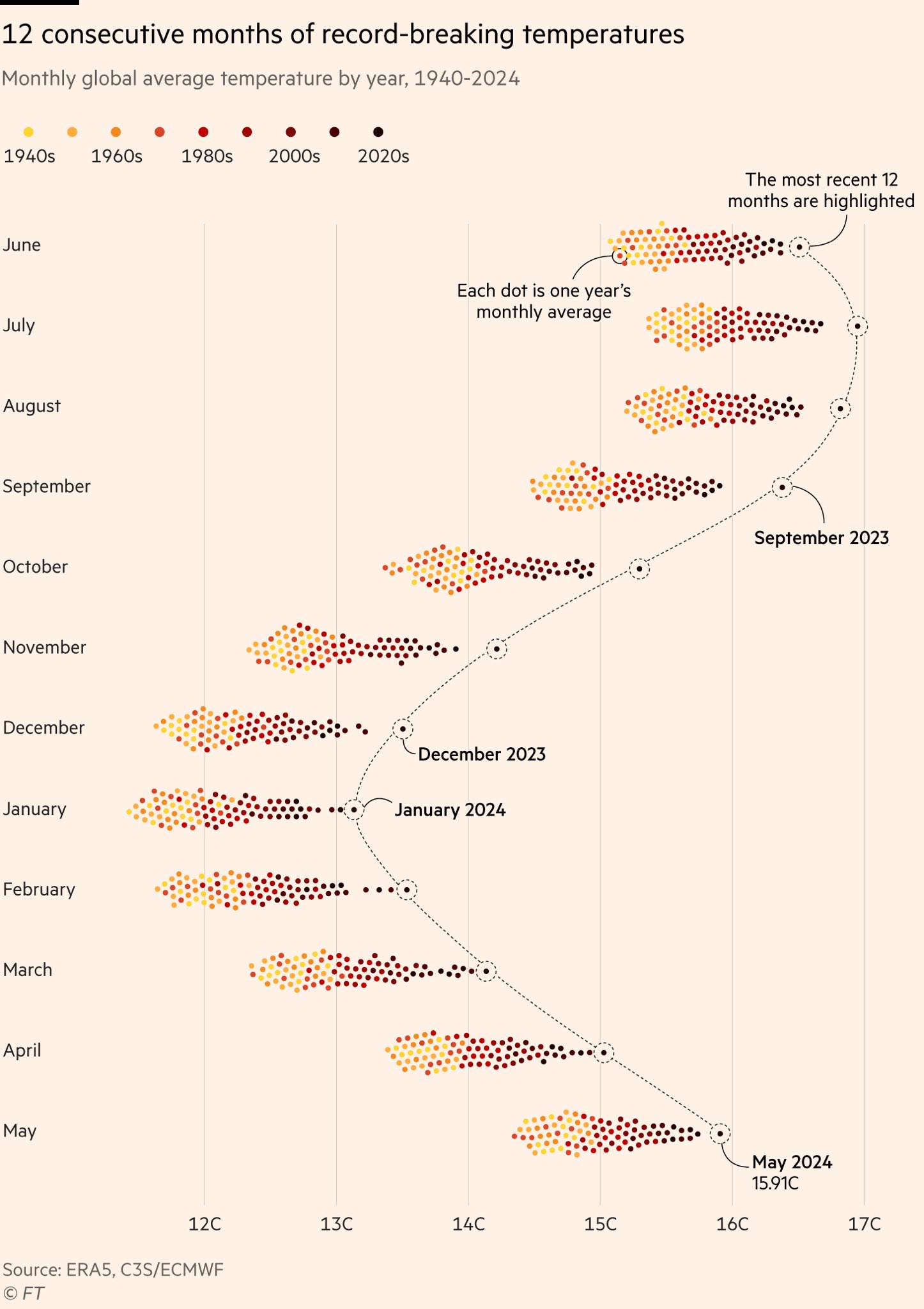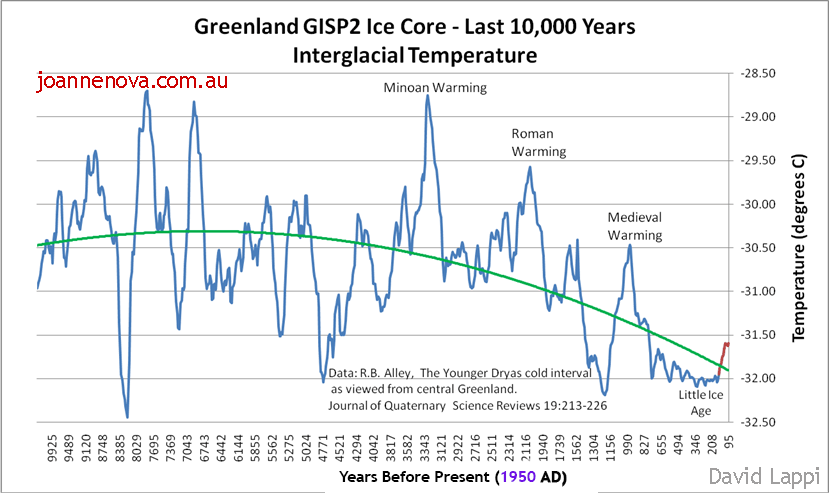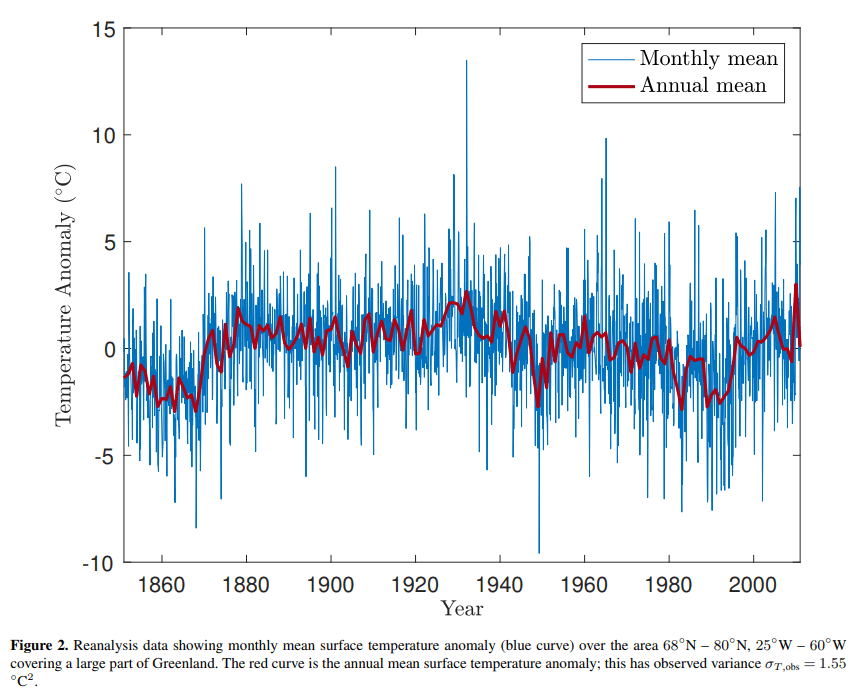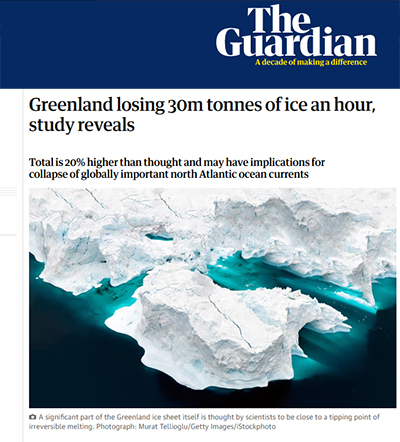
Moderators: Elvis, DrVolin, Jeff
DrEvil » 27 May 2024 22:52 wrote:Something is very obviously out of whack. It's still spring where I live, but it feels like July/August from twenty years ago.
Abstract
Human activities affect the Earth’s climate through modifying the composition of the atmosphere, which then creates radiative forcing that drives climate change. The warming effect of anthropogenic greenhouse gases has been partially balanced by the cooling effect of anthropogenic aerosols. In 2020, fuel regulations abruptly reduced the emission of sulfur dioxide from international shipping by about 80% and created an inadvertent geoengineering termination shock with global impact. Here we estimate the regulation leads to a radiative forcing of
Wm−2 averaged over the global ocean. The amount of radiative forcing could lead to a doubling (or more) of the warming rate in the 2020 s compared with the rate since 1980 with strong spatiotemporal heterogeneity. The warming effect is consistent with the recent observed strong warming in 2023 and expected to make the 2020 s anomalously warm. The forcing is equivalent in magnitude to 80% of the measured increase in planetary heat uptake since 2020. The radiative forcing also has strong hemispheric contrast, which has important implications for precipitation pattern changes. Our result suggests marine cloud brightening may be a viable geoengineering method in temporarily cooling the climate that has its unique challenges due to inherent spatiotemporal heterogeneity.






During the depths of the last ice age Greenland temperatures would swing abruptly by 10 to 15 degrees Celsius (or 30F) in the space of 30 years. And we’re panicking at the moment about warming at 0.13°C per decade.
Applications in Engineering Science
Volume 17, March 2024, 100170
Climatic consequences of the process of saturation of radiation absorption in gases
Jan Kubicki, Krzysztof Kopczyński, Jarosław Młyńczak
Abstract
This article provides a brief review of research on the impact of anthropogenic increase in atmospheric CO2 concentration on Earth's climate. A simplified analysis of resonant radiation absorption in gases is conducted. Building upon the material from the cited articles, theoretical and empirical relationships between radiation absorption and the mass of the absorbing material are presented. The concept of saturation mass is introduced. Special attention is given to the phenomenon of thermal radiation absorption saturation in carbon dioxide. By comparing the saturation mass of CO2 with the quantity of this gas in Earth's atmosphere, and analyzing the results of experiments and measurements, the need for continued and improved experimental work is suggested to ascertain whether additionally emitted carbon dioxide into the atmosphere is indeed a greenhouse gas.
Significance statement
• The impact of anthropogenic increase in atmospheric CO2 concentration on Earth's climate is analysed. • The concept of saturation mass is introduced. • By comparing the saturation mass of CO2 with the quantity of this gas in Earth's atmosphere, and analyzing the results of experiments and measurements, the need for continued and improved experimental work is suggested to ascertain whether additionally emitted carbon dioxide into the atmosphere is indeed a greenhouse gas.
1. Introduction
Due to the overlap of the absorption spectra of certain atmospheric gases and vapours with a portion of the thermal radiation spectrum from the Earth's surface, these gases absorb the mentioned radiation. This leads to an increase in their temperature and the re-emission of radiation in all directions, including towards the Earth. As a result, with an increase in the concentration of the radiation-absorbing gas, the temperature of the Earth's surface rises. Due to the observed continuous increase in the average temperature of the Earth and the simultaneous increase in the concentration of carbon dioxide in the atmosphere, it has been recognized that the increase in atmospheric carbon dioxide concentration associated with human activity may be the cause of climate warming.
This phenomenon was already noted by Arrhenius (1896). The United Nations, concerned about climate change, established the Intergovernmental Panel on Climate Change (IPCC) to provide objective scientific information about climate change. The IPCC prepares comprehensive Assessment Reports on climate change knowledge, its causes, potential impacts, and response options. IPCC reports are assessments of published literature and are prepared by hundreds of experts from various fields. In addition, since 1995, United Nations Climate Change Conferences (known as Conference of the Parties - COP) have been held to negotiate actions related to climate policy. Authors of various books and publications refer to the IPCC reports. They often agree on the credibility of the forecasts made by the IPCC (Anderson et al., 2016; Ramanathan 1988; Karl and Trenberth 2003; Hansen et al., 1981; Kellogg 1987). These forecasts provide compelling arguments that in response to the ongoing emissions of CO2 and other greenhouse gases into the atmosphere, the global climate will continue to undergo significant warming. However, individual studies highlight various details often not included in IPCC reports. For example, studies
Madden and Ramanathan (1980) demonstrate the possibility of climate warming delays compared to the projections based on mathematical models, caused, among other factors, by the thermal inertia of the oceans. Furthermore, the need for increased research to better understand climate processes is emphasized by the author of (Jain 1993).
However, in most published works, the negative impact of anthropogenic increases in atmospheric CO2 concentration on the Earth's climate is considered established, and much attention is given to the consequences of climate change. In addition to glacial melting and rising sea levels, local issues are often highlighted. For instance, in Woolway et al. (2020), it is stated that climate change is one of the most serious threats to global lake ecosystems.
Sometimes, in addition to reducing CO2 emissions, capturing this gas from the atmosphere is proposed (Breyer et al., 2019). Methods that aim to compensate for the greenhouse effect by increasing albedo are also proposed (Goldblatt et al., 2013;Akbari et al., 2009).
However, there are studies that recognize the need for more substantial supplements or changes to the computer models adopted by the IPCC. This includes emphasizing the role of clouds in the adopted models (Mitchell 1989; Abbood and Al-Taai 2018; Alados Arboledas et al., 1995; Sakurai et al., 2005). In some studies, such as Trenberth and Fasull (2009), it is noted that the adopted models do not account for the fact that the greenhouse effect caused by increasing greenhouse gases and water vapor (as a feedback) is balanced by a decrease in cloud cover and, therefore, an increase in radiation emissions. The need for a more serious consideration of aerosols in the conducted research is also emphasized. For example, study (Landsberg 1970) states that aerosols produced by humans, due to their optical properties and potential influence on cloud and precipitation formation processes, pose a more significant problem than CO2. Additionally,
Wild (2016) shows that subtle changes in aerosols over large ocean areas, amplified by aerosol-cloud interactions, can significantly alter incoming solar radiation and, consequently, change sea surface temperatures. The author of Palmer (1999) pays significant attention to the accuracy of descriptions, stating, among other things, that errors in simulating local air-sea heat fluxes can exceed the direct effect of doubling CO2. Reservations about the adopted models are also presented by the author of (Shine and de F Forster, 1999). The study shows that the research attributing observed climate changes to human activity only considered a part of all the mechanisms driving these changes, and therefore, the conclusions can be unquestionable only when all these mechanisms are taken into account.
...


https://x.com/brainsturbator/status/1815826962474025246@brainsturbator
·
Microsoft "Efficiency Mode" is a lean metaphor for pretty much 100% of the neolib climate change response toolkit.
Has zero effect on the problem, makes things harder on end users, and because everything takes longer, the only real result is higher power consumption overall.
New research indicates the rapid increase in the rate of sea level rise along the U.S. Southeast Coast since 2010 is due partly to natural variability factors, and that the rate of sea level rate might slow in the next five years
John Lee Pettimore
@JohnLeePettim13
46 Reasons why wind turbines cannot replace fossil fuels.
1 Windmills require petroleum every single step of their life cycle. If they can’t replicate themselves using wind turbine generated electricity, they are not sustainable.
2 SCALE. Too many windmills needed to replace fossil fuels.
3 SCALE. Wind turbines can’t be built fast enough to replace [hydrocarbon fuel]
4 Not enough materials such as rare earth metals or fossil fueled heat to create the cement, steel, epoxy, and other parts needed.
5 Not enough dispatchable power, such as natural gas or hydropower, to balance wind intermittency and unreliability.
6 Wind blows seasonally, so for much of there year there isn’t much wind.
7 When too much wind is blowing for the grid to cope with and not blackout, it has to be curtailed. If the wind is over 55 mph the wind turbine also has to shut down or risk being damaged.
8 The best wind areas will never be developed – they’re too far from cities and the Grid.
9 The Grid Can’t Handle Wind Power without natural gas.
10 The role of the grid is to keep the supply of power steady and predictable. Wind does the opposite, at some point of penetration it may become impossible to keep the grid from crashing.
11 Windmills wouldn’t be built without huge subsidies and tax breaks.
12 Tremendous environmental damage from mining material for windmills.
13 Wind is only strong enough to justify windmills in a few regions.
14 The electric grid needs to be much larger than it is now.
15 Wind blows the strongest when customer demand is the weakest.
16 No utility scale energy storage in sight.
17 Wind Power surges harm industrial customers.
18 Energy returned on Energy Invested is negative.
19 Wind Turbines break down too often.
20 Wind doesn’t reduce CO2.
21 Turbines increase the cost of farming.
22 Offshore Windmills battered by waves, wind, ice, corrosion, a hazard to ships and ecosystems.
23 Wind turbines are far more expensive than they appear to be.
24 Wind turbines are already going out of business and fewer built in Europe.
25 Windmills are so huge they’ve reached the limits of land transportation by truck or rail.
26 Windmills may only last 12 to 15 years, or at best 20 years.
27 Offshore wind turbines could affect fisheries.
28 Wind has a low capacity Factor.
29 The quality of wind resources is location specific, with the best locations often found far from the load center where the transmission grid already exists.
30 Dead bugs and salt reduce wind power generation by 20 to 30%
31 Germany has been spending more for much longer than other nations, and Energiewiende is a huge failure.
32 Wind turbines more expensive to decommission than construct so often not recycled.
33 Decommissioning wind turbines costs as much as $500,000 per wind turbine.
34 Wind turbines threaten biodiversity in hundreds of protected, key biodiversity, and wilderness areas.
35 Wind turbines and solar PV depend on the energy storage of coal and natural gas plants to provide power when the wind dies.
36 Operations and Maintenance (O&M) costs are too high.
Increasingly high insurance costs from hurricanes, wildfires, tornadoes, defective equipment, untrained personnel and more
37 Turbines can’t be improved much, they are nearing the maximum possible harvesting of wind.
Turbines are so heavy they damage roads during delivery
38 Not enough metallurgical coal to make the steel for wind turbines.
39 When oil prices rise, the cost of building wind turbines rises.
40 Electricity can’t make cement, steel, glass, bricks, ceramics.
41 Wind turbines are ecologically destructive.
42 Supply chains: wind turbines need 10 times the materials of conventional energy technologies.
43 Wind turbines are buckling and toppling, splatting wind blades across fields and oceans. See Nantucket.
44 We can’t make wind turbines more efficient because we don’t understand turbulence.
45 Peak wind? Wind generation declined in 2023 for the first time since the 1990s.
46 Betz Limit of 59% — another 10-fold increase is not possible.
As Warren Buffett said, " "For example, on wind energy, we get a tax credit if we build a lot of wind farms. That's the only reason to build them. They don't make sense without the tax credit."
While the wind production tax credit may be great for the rich, it's harmful for taxpayers and energy consumers. The more wind turbines the higher the cost of electricity, and who suffers the most? The poor.
#GreenEnergy
Users browsing this forum: No registered users and 4 guests